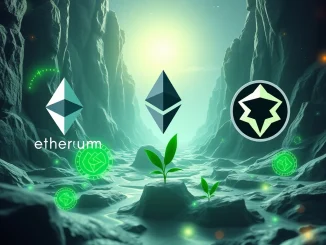
The world of data is rapidly evolving, and the lines between traditional enterprise systems and decentralized Web3 technologies are starting to blur. For developers and businesses looking to harness the power of blockchain data, accessing and integrating it has often been a complex challenge. But what if a major enterprise data platform made it simple? That’s exactly what’s happening with the latest development involving Microsoft Fabric.
What is Microsoft Fabric and Why Does Space and Time Matter?
Microsoft Fabric is Microsoft’s comprehensive, AI-powered data and analytics platform. It’s designed to bring together various data workloads and experiences into a single environment, helping organizations manage, analyze, and derive insights from vast amounts of data. Think of it as a unified hub for all your data needs, from data warehousing and data engineering to data science and real-time analytics.
Traditionally, accessing and analyzing data from public blockchains like Bitcoin and Ethereum within such a platform was difficult. This is where Space and Time (SXT) comes in. Space and Time is a decentralized data warehouse purpose-built for Web3. It’s designed to connect on-chain and off-chain data, providing developers with the ability to perform complex queries and analytics using familiar tools like SQL, but with the added security and verifiability of zero-knowledge proofs.
The integration of Space and Time into Microsoft Fabric is a significant step because it bridges the gap between enterprise data infrastructure and the burgeoning world of Web3 data. It positions SXT as the first Web3 data provider directly accessible within the Fabric ecosystem.
How Does This Integration Provide Web3 Data Access?
The core mechanism for accessing this data is through Microsoft’s Azure OneLake platform. Azure OneLake is a single, logical data lake that comes automatically with every Microsoft Fabric tenant. It acts as the foundation for storing and managing data within Fabric.
With this integration, developers using Microsoft Fabric can now pull real-time Web3 data directly from Space and Time via Azure OneLake. This means data from major blockchains like Bitcoin, Ethereum, and other networks can be seamlessly queried and combined with existing enterprise data within the Fabric environment.
Key aspects of the integration:
- Direct Access: Developers don’t need to build custom connectors or complex pipelines to get blockchain data into their analytics workflows.
- Real-Time Data: Access to up-to-date information from the blockchain networks.
- Unified Platform: Combine Web3 data with other enterprise data sources within the single Microsoft Fabric environment.
- Familiar Tools: Utilize Fabric’s existing analytics tools and interfaces to work with the blockchain data.
What Are the Benefits of Combining Enterprise and Blockchain Data?
Bringing Blockchain data into an enterprise analytics platform like Microsoft Fabric unlocks a wealth of possibilities. Businesses and developers can gain deeper insights by correlating decentralized data with their traditional datasets.
Potential benefits include:
- Enhanced Supply Chain Transparency: Track goods on a blockchain while analyzing internal logistics data within Fabric.
- Advanced Financial Analysis: Combine on-chain transaction data (like DeFi activity) with traditional market data and internal financial records.
- Improved Gaming Analytics: Analyze in-game NFT ownership and transaction data alongside player behavior and monetization data.
- Verifiable Data Insights: Leverage Space and Time’s verifiable computation to ensure the integrity of blockchain-derived insights.
- Building Next-Gen Applications: Develop applications that leverage both enterprise and Web3 data streams for richer functionality.
This integration provides a powerful toolset for developers looking to build hybrid Web2/Web3 solutions or for enterprises seeking to understand and utilize blockchain ecosystems.
Are There Any Challenges or Considerations?
While this integration is a major leap forward, users should be mindful of certain factors:
- Data Volume: Blockchain data can be massive. Efficient querying and storage within Fabric are important.
- Data Complexity: Understanding the structure and nuances of different blockchain datasets is necessary for effective analysis.
- Security and Privacy: While blockchain data is public, combining it with private enterprise data requires careful consideration of data governance and compliance.
Space and Time’s focus on verifiable computation helps address data integrity, but the responsibility of how data is used and combined within Fabric rests with the user.
What Does This Mean for the Future of Enterprise Web3 Adoption?
This move by Microsoft, integrating a native Web3 data provider like Space and Time into its flagship data platform, signals a growing recognition of the importance of decentralized data. It lowers the barrier to entry for enterprises and developers who want to experiment with or build upon blockchain technology without leaving their familiar Microsoft ecosystem.
The ability to easily access and analyze Blockchain data alongside traditional data within Microsoft Fabric via Azure OneLake could accelerate enterprise exploration and adoption of Web3 use cases, from tokenization and decentralized identity to verifiable supply chains and beyond.
Conclusion: Unlocking New Possibilities with Integrated Data
The integration of Space and Time into Microsoft Fabric marks a significant milestone in bringing Web3 capabilities into the mainstream enterprise data landscape. By providing seamless access to real-time blockchain data via Azure OneLake, Microsoft Fabric empowers developers and businesses to unlock new insights, build innovative applications, and bridge the gap between centralized and decentralized data environments. This development is poised to accelerate the convergence of traditional data analytics and the exciting potential of Web3.



